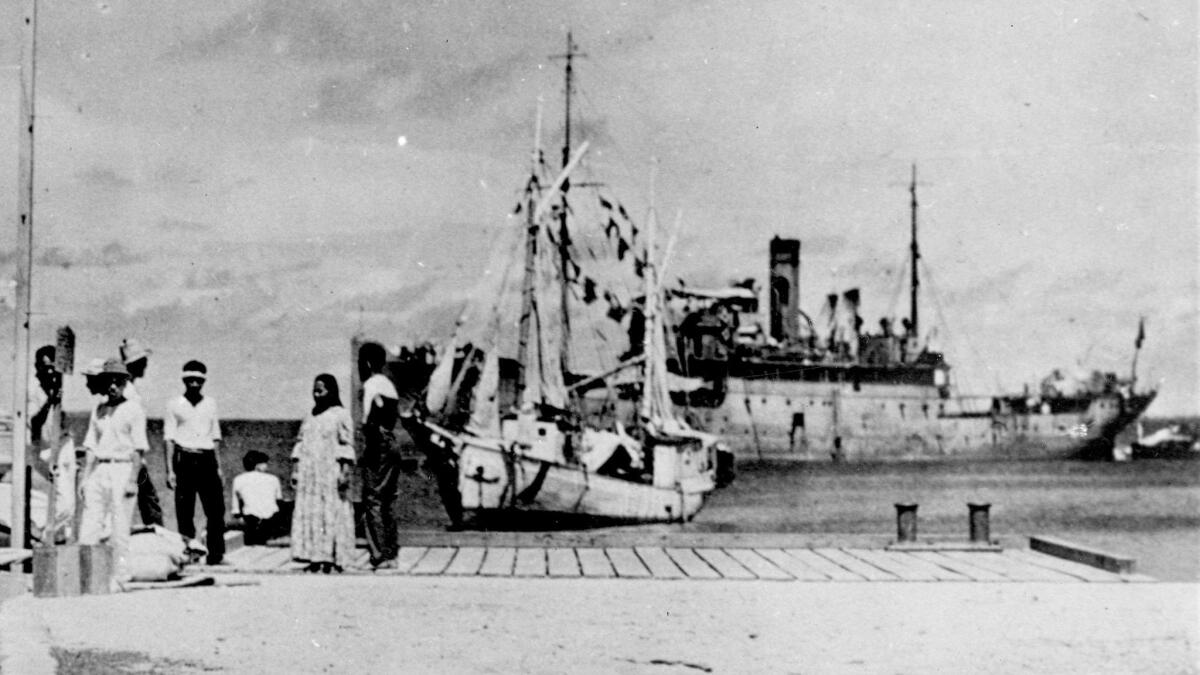Commentary: Amelia Earhart, subject of new documentary, had ties to O.C.

- Share via
Three summers ago, I was standing in a secluded jungle clearing on Saipan, the capital of the Northern Marianas Islands, a U.S. territory in the remote western Pacific about 6,000 miles from the West Coast of the United States.
Before me lay the crumbling stone ruins of the notorious Japanese Jail, where the armed forces of the Japanese Empire — which had taken possession of the islands from Germany following the end of World War I — had incarcerated, starved and executed native Chamorros, U.S. prisoners of war and American civilians before and during World War II.
Among those prisoners were, reportedly, Amelia Earhart, the famed aviator who, as I will elaborate on later, had long-standing Orange County ties, and Fred Noonan, her navigator, who, along with their twin-engine Lockheed Electra aircraft, had mysteriously vanished in the Pacific on July 2, 1937, during their historic attempt to circumnavigate the world.
As I walked unescorted through the jail, which lies between the beach highway and the Saipan cockfighting arena, a young man who lived across the road came over to greet me and volunteer to be my guide.
“There were about 25 cells for men and five for women. Each was equipped with a Japanese-style squat toilet, a hole in the ground. This is where Miss Earhart and Mr. Noonan were kept,” he said, pointing to filthy, trash-filled cubicles surrounded by thick, rusting metal bars.
He, like most Saipanese I met on the island during my visit in June 2014, was convinced Earhart and Noonan were imprisoned and executed in the jail.
But that theory has long been dismissed by those who believe the aviators met their deaths when their plane crashed into the sea on or near Gardner Island, also named Nikumaroro, or U.S.-held Howland Island, where they were to have refueled before flying to Hawaii and Oakland.
But what befell Amelia Earhart, the first woman to fly the Atlantic, the first woman to fly in an autogiro (the forerunner of the helicopter), the first person to fly from Hawaii to the mainland, the winner of countless air races and one of this nation’s pioneering feminists?
The theory put forth by my young guide, that she and Noonan were taken to the Japanese Jail and executed, is correct, according to a television special recently aired on the History Channel.
During the two-hour presentation titled “Amelia Earhart: The Lost Evidence,” a former assistant executive director of the FBI produced what he said was a newly-unearthed photograph discovered in the National Archives that supposedly pictures Earhart and Noonan at a pier in the Japanese-held Marshall Islands. In the background can be seen the Japanese warship Koshu Maru, its stern tied up to a barge on which sat the aviators’ airplane.
According to information provided by the History Channel, Earhart and Noonan crash-landed in the Marshall Islands when their plane ran out of fuel. The pair were arrested, and they and their plane were transported by the Koshu Maru to Saipan, where they were thrown in the Japanese Jail and later executed. The plane was cut up into scraps.
But the History Channel’s reporting is now being questioned by the release of new evidence that indicates the photograph was published in a Japanese travel magazine nearly two years before the aviators vanished. Earhart and Noonan are not the individuals in the photo, according to this new evidence.
Should we be skeptical of all theories relating to the disappearance of the fliers? My answer is a definite “yes.”
As for Earhart’s connections to Orange County: In the early and mid-1930s, she and her husband, George P. Putnam, an heir to the Putnam publishing fortune, made their home in the Los Angeles suburb of Toluca Lake, a 5-mile drive to the Burbank Airport, from where she often flew to Crawford Field, a dirt strip at the corner of Pacific Coast Highway and Seal Beach Boulevard in Seal Beach.
From there, she would fly on brief jaunts along the Orange Coast with fellow pilots such as Howard Hughes, Charles Lindbergh, Paul Mantz and Eddie Martin, founder of Eddie Martin Field which years later would become Orange County Airport and, in 1979, would be renamed John Wayne Airport.
When the sun went down, Earhart and the others would adjourn for drinks and dinner at the Glide’er Inn across the road from Crawford Field. The restaurant — easily recognized by the small airplane that sat on its roof — and the airfield were demolished in 1944 to make way for the Seal Beach Naval Weapons Station. The Glide’er Inn was reestablished at the corner of 14th Street and Seal Beach Boulevard, but later sold to new owners who renamed it Mahe Restaurant.
Earhart flew often to Orange County Airport to consult with stunt-flyer Mantz, who counseled her on piloting techniques. Mantz, who founded an aviation services company at the airport with pilot Frank Tallman, was killed in 1965 when his plane crashed in the Arizona desert during the filming of “The Flight of the Phoenix.”
What caused Earhart, Noonan and their plane to vanish in the Pacific? Were they really jailed and executed in the Marianas, which fell into U.S. hands at the end of World War II? Alas, we may never learn the true story of the aviators’ fate.
DAVID C. HENLEY is a Newport-Beach based contributor to the Times Community News.
All the latest on Orange County from Orange County.
Get our free TimesOC newsletter.
You may occasionally receive promotional content from the Daily Pilot.



